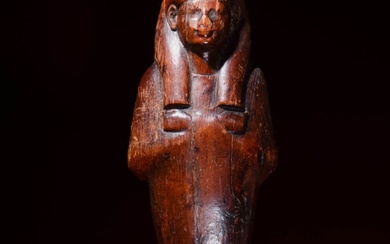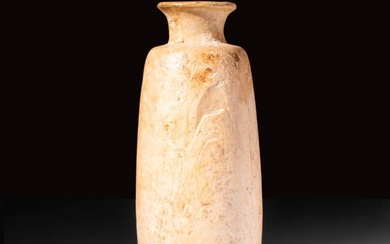Tall Egyptian New Kingdom Wood Ushabti, ex-Merrin
Ancient Egypt, New Kingdom, 18th Dynasty, between the reigns of Amenhotep II, Thutmose IV, and Amenhotep III, ca. 1408 to 1372 BCE. A breathtaking and sizable example of a standing ushabti figure carved from dense hardwood, perhaps cedar, presenting a dignified posture and lustrous patina in hues of caramel and coffee. The figure presents in the classic mummiform pose with fused legs and protruding feet, stands with arms held tightly against the sides, and crosses both hands atop the sternum. The pick and hoe typically seen in relief on other shabti figures were perhaps painted atop the wooden surface along with other vibrant embellishments. The haunting countenance peers forward with hollow orbitals and bears a flush nose, full lips turned into a slight smile, and tapered cheeks, with recessed, lightly cupped ears, all framed within the lappets of a headdress that rests low along the brow. Visible wood grain across the figure creates an organic and awe-inspiring example of exemplary Egyptian funerary artistry! Size: 3.2" W x 10.375" H (8.1 cm x 26.4 cm); 11.875" H (30.2 cm) on included custom stand.
Ushabti dolls are figures shaped like adult male or female mummies wearing traditional ancient Egyptian headdresses. The ancient Egyptians believed that after they died, their spirits would have to work in the "Field of Reeds" owned by the god of the underworld, Osiris. As a result, they are frequently depicted with arms crossed, holding picks and hoes, with baskets on their backs. This meant that the task of agricultural labor was required by all members of society, from workers to pharaohs. The wealthier nobility in Egyptian society were able to have ushabti made of faience, though wood was a more economical option for members of lower classes. However, the overall size of this example suggests that this was meant for an individual of importance.
Cf. The British Museum, museum number EA8659
An example from the early New Kingdom period hammered for $43,750 at Sotheby's, New York "Antiquities" auction (June 5, 2008, lot 48)
This piece has been searched against the Art Loss Register database and has been cleared. The Art Loss Register maintains the world’s largest database of stolen art, collectibles, and antiques.
Provenance: private New York, USA collection; ex-R. Liechti (1934-2010) collection, Geneva, Switzerland, acquired circa 1990; ex-Merrin Gallery; ex-Arthur Bowen Davies (1860-1928, American artist), New York, USA
All items legal to buy/sell under U.S. Statute covering cultural patrimony Code 2600, CHAPTER 14, and are guaranteed to be as described or your money back.
A Certificate of Authenticity will accompany all winning bids.
PLEASE NOTE: Due to recent increases of shipments being seized by Australian & German customs (even for items with pre-UNESCO provenance), we will no longer ship most antiquities and ancient Chinese art to Australia & Germany. For categories of items that are acceptable to ship to Australia or Germany, please contact us directly or work with your local customs brokerage firm.
Display stands not described as included/custom in the item description are for photography purposes only and will not be included with the item upon shipping.
#164980
Condition Report: Figure repaired from two vertical pieces, with repairs also to front of feet, and light adhesive residue along break lines. Light abrasions to body and head, with softening to features of face and hands, a few stable hairline fissures, and a couple of small spalls. Beautiful patina and incredibly smooth surface texture throughout. Hole drilled through bottom of feet for mounting on display stand. Old inventory label beneath display stand.
View it on
Sale price
Estimate
Time, Location
Auction House
Ancient Egypt, New Kingdom, 18th Dynasty, between the reigns of Amenhotep II, Thutmose IV, and Amenhotep III, ca. 1408 to 1372 BCE. A breathtaking and sizable example of a standing ushabti figure carved from dense hardwood, perhaps cedar, presenting a dignified posture and lustrous patina in hues of caramel and coffee. The figure presents in the classic mummiform pose with fused legs and protruding feet, stands with arms held tightly against the sides, and crosses both hands atop the sternum. The pick and hoe typically seen in relief on other shabti figures were perhaps painted atop the wooden surface along with other vibrant embellishments. The haunting countenance peers forward with hollow orbitals and bears a flush nose, full lips turned into a slight smile, and tapered cheeks, with recessed, lightly cupped ears, all framed within the lappets of a headdress that rests low along the brow. Visible wood grain across the figure creates an organic and awe-inspiring example of exemplary Egyptian funerary artistry! Size: 3.2" W x 10.375" H (8.1 cm x 26.4 cm); 11.875" H (30.2 cm) on included custom stand.
Ushabti dolls are figures shaped like adult male or female mummies wearing traditional ancient Egyptian headdresses. The ancient Egyptians believed that after they died, their spirits would have to work in the "Field of Reeds" owned by the god of the underworld, Osiris. As a result, they are frequently depicted with arms crossed, holding picks and hoes, with baskets on their backs. This meant that the task of agricultural labor was required by all members of society, from workers to pharaohs. The wealthier nobility in Egyptian society were able to have ushabti made of faience, though wood was a more economical option for members of lower classes. However, the overall size of this example suggests that this was meant for an individual of importance.
Cf. The British Museum, museum number EA8659
An example from the early New Kingdom period hammered for $43,750 at Sotheby's, New York "Antiquities" auction (June 5, 2008, lot 48)
This piece has been searched against the Art Loss Register database and has been cleared. The Art Loss Register maintains the world’s largest database of stolen art, collectibles, and antiques.
Provenance: private New York, USA collection; ex-R. Liechti (1934-2010) collection, Geneva, Switzerland, acquired circa 1990; ex-Merrin Gallery; ex-Arthur Bowen Davies (1860-1928, American artist), New York, USA
All items legal to buy/sell under U.S. Statute covering cultural patrimony Code 2600, CHAPTER 14, and are guaranteed to be as described or your money back.
A Certificate of Authenticity will accompany all winning bids.
PLEASE NOTE: Due to recent increases of shipments being seized by Australian & German customs (even for items with pre-UNESCO provenance), we will no longer ship most antiquities and ancient Chinese art to Australia & Germany. For categories of items that are acceptable to ship to Australia or Germany, please contact us directly or work with your local customs brokerage firm.
Display stands not described as included/custom in the item description are for photography purposes only and will not be included with the item upon shipping.
#164980
Condition Report: Figure repaired from two vertical pieces, with repairs also to front of feet, and light adhesive residue along break lines. Light abrasions to body and head, with softening to features of face and hands, a few stable hairline fissures, and a couple of small spalls. Beautiful patina and incredibly smooth surface texture throughout. Hole drilled through bottom of feet for mounting on display stand. Old inventory label beneath display stand.






